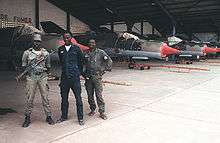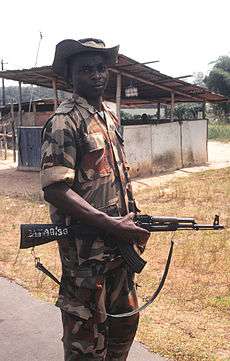Economic Community of West African States Monitoring Group
The Economic Community of West African States Monitoring Group (ECOMOG) was a West African multilateral armed force established by the Economic Community of West African States (ECOWAS). ECOMOG was a formal arrangement for separate armies to work together. It was largely supported by personnel and resources of the Nigerian Armed Forces, with sub-battalion strength units contributed by other ECOWAS members — Ghana, Guinea, Sierra Leone, The Gambia, Liberia, Mali, Burkina Faso, Niger, and others.

History
Nigeria and other ECOWAS members agreed to a Protocol on Mutual Defence Assistance, in Freetown, Sierra Leone, on 29 May 1981. Among other organs such as a Defence Committee and Council, it provided for the establishment of an Allied Armed Force of the Community (AAFC) as needed.
Anglophone ECOWAS members established ECOMOG in 1990 to intervene in the civil war in Liberia (1989–96). Nigerian scholar Adekeye Adebajo wrote in 2002 that "there was merit...in the argument that the establishment of ECOMOG did not conform to the constitutional legal requirements of ECOWAS". The Standing Mediation Committee, the body that established ECOMOG at its meeting in Banjul, Gambia on 6–7 August 1990, was 'on shaky legal foundations.'[1] Adebajo concludes that the arguments used to establish ECOMOG had more solid grounds in politics than in law. The Defence Protocol's guidelines were not followed, and ECOMOG was justified largely on humanitarian grounds.
Within Africa, ECOMOG represented the first credible attempt at a regional security initiative since the Organisation of African Unity (OAU) tried to established an 'Inter-African Force' to intervene in Chad in 1981.
Anglophone members of ECOMOG acted because several Francophone ECOWAS members strongly opposed the deployment.[2] The leaders of Burkina Faso and Cote d'Ivoire supported Charles Taylor in his attempt to depose Samuel Doe. Unlike the typical UN mission of its day, ECOMOG's first deployment entailed fighting its way into a many-sided civil war, in an attempt to forcibly hold the warring factions apart.

The first Force Commander was Ghanaian Lieutenant General Arnold Quainoo, but he was succeeded by an unbroken line of Nigerian officers. Major General Joshua Dogonyaro took over from Quainoo after Quainoo had left Monrovia for consultations with senior ECOWAS officials soon after the death of Samuel Doe at the hands of Prince Johnson's Independent National Patriotic Front of Liberia on 9 September 1990.[3]
After some prompting from Taylor that the anglophone Nigerians were opposed to him, Senegalese troops were brought in with some financial support from the United States.[4] Their service was, however, short-lived, after a major confrontation with Taylor forces in Vahun, Lofa County on 28 May 1992, when six were killed when a crowd of NPFL supporters surrounded their vehicle and demanded they surrender their jeep and weapons.[5] All of Senegal's 1,500 soldiers were withdrawn by mid January 1993.
Throughout the mission, corruption and organized looting by ECOMOG troops led some Liberians to re-coin the acronym ECOMOG as "Every Car or Movable Object Gone." Stephen Ellis reports one of the most egregious examples as being the total removal of iron ore processing machinery for onward sale while the Buchanan compound was under ECOMOG control.[6]
The United States State Department provided some logistics support to the force via the U.S. company Pacific Architects & Engineers, which provided trucks and drivers.[7] Five Air Force C-130 Hercules also moved African troops and supplies during Operation Assured Lift in February–March 1997.[8]
Following Charles Taylor's election as President of Liberia on 19 July 1997, the final Field Commander, General Timothy Shelpidi, withdrew the force fully by the end of 1998.
ECOWAS deployed ECOMOG forces later on to control conflict in other cases:
- 1997 — Sierra Leone, to stop the RUF rebellion.
- 1999 — Guinea-Bissau,[9] to end the Guinea-Bissau Civil War
In 2001, ECOWAS planned to deploy 1,700 men along the Guinea–Liberia border to stop guerrilla infiltration by fighters opposed to the new post-1998 election government. However, fighting between Charles Taylor's new government and the new LURD rebel movement, plus a lack of funding, meant no force was actually ever deployed.[10]
In 2003 ECOWAS, under pressure from the United States, launched a similar mission named ECOMIL to halt the occupation of Monrovia by rebel forces as peace efforts were ongoing, during the Second Liberian Civil War.[11] Always intended as an interim force, it was quickly succeeded by the United Nations mission UNMIL.
ECOMOG Commanders
Below is a chronological list of ECOMOG commanders:[12]
Liberia
| Commander | Country | Title | Dates |
|---|---|---|---|
| Lt-Gen. Arnold Quainoo | Ghana | Force Commander | July 1990 - September 1990 |
| Maj-Gen. Joshua Dogonyaro | Nigeria | Field Commander | September 1990 - February 1991 |
| Maj-Gen. Rufus Kupolati | Nigeria | Field Commander | February 1991 - September 1991 |
| Maj-Gen. Ishaya Bakut | Nigeria | Field Commander | September 1991- October 1992 |
| Maj-Gen. Tunji Olurin | Nigeria | Field Commander | October 1992 - October 1993 |
| Maj-Gen. John Shagaya | Nigeria | Field Commander | October 1993 - December 1993 |
| Maj-Gen. John Mark Inienger | Nigeria | Field Commander | December 1993 - August 1996 |
| Maj-Gen. Victor Malu | Nigeria | Force Commander | August 1996 - January 1998 |
| Maj-Gen. Timothy Shelpidi | Nigeria | Force Commander | January 1998 - March 1999 |
| Maj-Gen. Felix Mujakperuo | Nigeria | Force Commander | 1999 |
Sierra Leone
| Commander | Year(s) |
|---|---|
| Major General Gabriel Kpamber | 2000 |
| Brigadier General Abu Ahmadu | 2000 |
| General Maxwell Khobe[13][14] | 1999 |
| Major General Felix Mujakperuo | 1999 |
| Brigadier-General Abdul One Mohammed | 1998 |
Notes
- Adekeye Adebajo, 'Liberia's Civil War: Nigeria, ECOMOG, and Regional Security in West Africa,' Lynne Rienner/International Peace Academy, 2002, p.64-5, also citing David Wippman, 'Enforcing Peace: ECOWAS and the Liberian Civil War,' in Lori Fisler Damrosch (ed), 'Enforcing Restraint, Collective Interventions in Internal Conflicts,' New York, Council on Foreign Relations, 1993, pp.157-203
- Berman and Sams, 2000, p.88-89
- Adekeye Adebajo, 'Liberia's Civil War: Nigeria, ECOMOG, and Regional Security in West Africa,' Lynne Rienner/International Peace Academy, 2002, p.78-79
- Adekeye Adebajo, 2002, p.107
- Adebajo, 2002, p.108
- The Mask of Anarchy, by Stephen Ellis, 2001, p.173. (There is also an NYU Press Updated Edition 2006, ISBN 0-8147-2238-5)
- Mitikishe Maxwell Khobe, The Evolution and Conduct of ECOMOG Operations in West Africa Archived 2013-04-05 at the Wayback Machine, in Monograph No.44, Institute for Security Studies, South Africa
- http://www.globalsecurity.org/military/ops/assured_lift.htm, accessed 2011
- United Nations Security Council Document 294. Report of the Secretary-General pursuant to Security Council Resolution 1216(1998) relative to the situation in Guinea-Bissau S/1999/294 17 March 1999. Retrieved 2008-07-01.
- Adebajo, 2002, p.234
- "Military". UNMIL. 2015-09-02. Retrieved 2020-03-05.
- Berman & Sams. Peacekeeping in Africa: Capabilities and Culpabilities. United Nations Publications UNIDIR, 2000. p. 95. ISBN 9789290451334. Retrieved 19 July 2015.
- General Khobe served as the chief of staff of the Sierra Leone army after the war. He died of Encephalitis at the St. Nicholas Hospital in Lagos, due to injury from the war.
- http://www.dawodu.com/barrack7.htm
References
- Adekeye Adebajo, 'Liberia's Civil War: Nigeria, ECOMOG, and Regional Security in West Africa,' Lynne Rienner/International Peace Academy, 2002
- Berman, Eric G.; Sams, Katie E. (2000). Peacekeeping In Africa : Capabilities And Culpabilities. Geneva: United Nations Institute for Disarmament Research. ISBN 92-9045-133-5.
External links
| Wikimedia Commons has media related to ECOMOG. |
- Assessment of ECOMOG's Liberia intervention published in "Human Rights Watch World Reports", Volume 5, Issue No. 6, June 1993,
- ECOMOG: A model for Africa? by Comfort Ero, Centre for Defence Studies, King's College London in Monograph No 46, February 2000 published by the Institute for Security Studies.
- Profile: Ecomog, BBC News Online, 17 June 2004.
- ECOMOG: Peacekeeper or Participant?, BBC News Online, February 11, 1998.
- U.S Citizenship and Immigration Services, Sierra Leone: Information on the 1997 coup d'état, ECOMOG harassment of civilians, and the current situation in Sierra Leone, 5 January 2000
